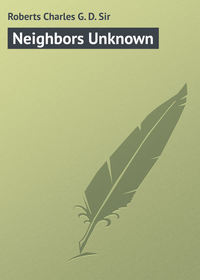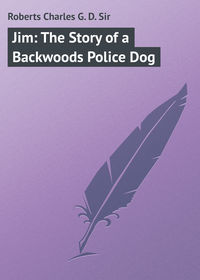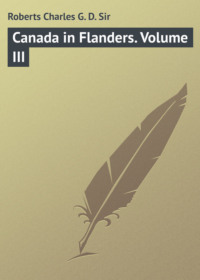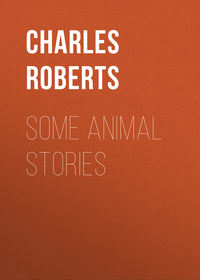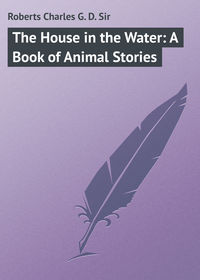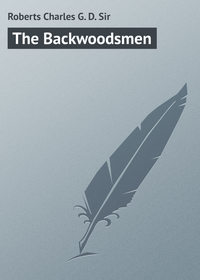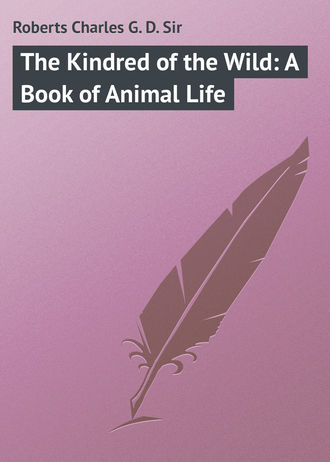 полная версия
полная версияThe Kindred of the Wild: A Book of Animal Life

Charles G. D. Roberts
The Kindred of the Wild: A Book of Animal Life
Introductory
The Animal Story
Alike in matter and in method, the animal story, as we have it to-day, may be regarded as a culmination. The animal story, of course, in one form or another, is as old as the beginnings of literature. Perhaps the most engrossing part in the life-drama of primitive man was that played by the beasts which he hunted, and by those which hunted him. They pressed incessantly upon his perceptions. They furnished both material and impulse for his first gropings toward pictorial art. When he acquired the kindred art of telling a story, they supplied his earliest themes; and they suggested the hieroglyphs by means of which, on carved bone or painted rock, he first gave his narrative a form to outlast the spoken breath. We may not unreasonably infer that the first animal story – the remote but authentic ancestor of “Mowgli” and “Lobo” and “Krag” – was a story of some successful hunt, when success meant life to the starving family; or of some desperate escape, when the truth of the narrative was attested, to the hearers squatted trembling about their fire, by the sniffings of the baffled bear or tiger at the rock-barred mouth of the cave. Such first animal stories had at least one merit of prime literary importance. They were convincing. The first critic, however supercilious, would be little likely to cavil at their verisimilitude.
Somewhat later, when men had begun to harass their souls, and their neighbours, with problems of life and conduct, then these same animals, hourly and in every aspect thrust beneath the eyes of their observation, served to point the moral of their tales. The beasts, not being in a position to resent the ignoble office thrust upon them, were compelled to do duty as concrete types of those obvious virtues and vices of which alone the unsophisticated ethical sense was ready to take cognisance. In this way, as soon as composition became a métier, was born the fable; and in this way the ingenuity of the first author enabled him to avoid a perilous unpopularity among those whose weaknesses and defects his art held up to the scorn of all the caves.
These earliest observers of animal life were compelled by the necessities of the case to observe truly, if not deeply. Pitting their wits against those of their four-foot rivals, they had to know their antagonists, and respect them, in order to overcome them. But it was only the most salient characteristics of each species that concerned the practical observer. It was simple to remember that the tiger was cruel, the fox cunning, the wolf rapacious. And so, as advancing civilisation drew an ever widening line between man and the animals, and men became more and more engrossed in the interests of their own kind, the personalities of the wild creatures which they had once known so well became obscured to them, and the creatures themselves came to be regarded, for the purposes of literature, as types or symbols merely, – except in those cases, equally obstructive to exact observation, where they were revered as temporary tenements of the spirits of departed kinsfolk. The characters in that great beast-epic of the middle ages, “Reynard the Fox,” though far more elaborately limned than those which play their succinct rôles in the fables of Æsop, are at the same time in their elaboration far more alien to the truths of wild nature. Reynard, Isegrim, Bruin, and Greybeard have little resemblance to the fox, the wolf, the bear, and the badger, as patience, sympathy, and the camera reveal them to us to-day.
The advent of Christianity, strange as it may seem at first glance, did not make for a closer understanding between man and the lower animals. While it was militant, fighting for its life against the forces of paganism, its effort was to set man at odds with the natural world, and fill his eyes with the wonders of the spiritual. Man was the only thing of consequence on earth, and of man, not his body, but his soul. Nature was the ally of the enemy. The way of nature was the way of death. In man alone was the seed of the divine. Of what concern could be the joy or pain of creatures of no soul, to-morrow returning to the dust? To strenuous spirits, their eyes fixed upon the fear of hell for themselves, and the certainty of it for their neighbours, it smacked of sin to take thought of the feelings of such evanescent products of corruption. Hence it came that, in spite of the gentle understanding of such sweet saints as Francis of Assisi, Anthony of Padua, and Colomb of the Bees, the inarticulate kindred for a long time reaped small comfort from the Dispensation of Love.
With the spread of freedom and the broadening out of all intellectual interests which characterise these modern days, the lower kindreds began to regain their old place in the concern of man. The revival of interest in the animals found literary expression (to classify roughly) in two forms, which necessarily overlap each other now and then, viz., the story of adventure and the anecdote of observation. Hunting as a recreation, pursued with zest from pole to tropics by restless seekers after the new, supplied a species of narrative singularly akin to what the first animal stories must have been, – narratives of desperate encounter, strange peril, and hairbreadth escape. Such hunters’ stories and travellers’ tales are rarely conspicuous for the exactitude of their observation; but that was not the quality at first demanded of them by fireside readers. The attention of the writer was focussed, not upon the peculiarities or the emotions of the beast protagonist in each fierce, brief drama, but upon the thrill of the action, the final triumph of the human actor. The inevitable tendency of these stories of adventure with beasts was to awaken interest in animals, and to excite a desire for exact knowledge of their traits and habits. The interest and the desire evoked the natural historian, the inheritor of the half-forgotten mantle of Pliny. Precise and patient scientists made the animals their care, observing with microscope and measure, comparing bones, assorting families, subdividing subdivisions, till at length all the beasts of significance to man were ticketed neatly, and laid bare, as far as the inmost fibre of their material substance was concerned, to the eye of popular information.
Altogether admirable and necessary as was this development at large, another, of richer or at least more spiritual significance, was going on at home. Folk who loved their animal comrades – their dogs, horses, cats, parrots, elephants – were observing, with the wonder and interest of discoverers, the astonishing fashion in which the mere instincts of these so-called irrational creatures were able to simulate the operations of reason. The results of this observation were written down, till “anecdotes of animals” came to form a not inconsiderable body of literature. The drift of all these data was overwhelmingly toward one conclusion. The mental processes of the animals observed were seen to be far more complex than the observers had supposed. Where instinct was called in to account for the elaborate ingenuity with which a dog would plan and accomplish the outwitting of a rival, or the nice judgment with which an elephant, with no nest-building ancestors behind him to instruct his brain, would choose and adjust the teak-logs which he was set to pile, it began to seem as if that faithful faculty was being overworked. To explain yet other cases, which no accepted theory seemed to fit, coincidence was invoked, till that rare and elusive phenomenon threatened to become as customary as buttercups. But when instinct and coincidence had done all that could be asked of them, there remained a great unaccounted-for body of facts; and men were forced at last to accept the proposition that, within their varying limitations, animals can and do reason. As far, at least, as the mental intelligence is concerned, the gulf dividing the lowest of the human species from the highest of the animals has in these latter days been reduced to a very narrow psychological fissure.
Whether avowedly or not, it is with the psychology of animal life that the representative animal stories of to-day are first of all concerned. Looking deep into the eyes of certain of the four-footed kindred, we have been startled to see therein a something, before unrecognised, that answered to our inner and intellectual, if not spiritual selves. We have suddenly attained a new and clearer vision. We have come face to face with personality, where we were blindly wont to predicate mere instinct and automatism. It is as if one should step carelessly out of one’s back door, and marvel to see unrolling before his new-awakened eyes the peaks and seas and misty valleys of an unknown world. Our chief writers of animal stories at the present day may be regarded as explorers of this unknown world, absorbed in charting its topography. They work, indeed, upon a substantial foundation of known facts. They are minutely scrupulous as to their natural history, and assiduous contributors to that science. But above all are they diligent in their search for the motive beneath the action. Their care is to catch the varying, elusive personalities which dwell back of the luminous brain windows of the dog, the horse, the deer, or wrap themselves in reserve behind the inscrutable eyes of all the cats, or sit aloof in the gaze of the hawk and the eagle. The animal story at its highest point of development is a psychological romance constructed on a framework of natural science.
The real psychology of the animals, so far as we are able to grope our way toward it by deduction and induction combined, is a very different thing from the psychology of certain stories of animals which paved the way for the present vogue. Of these, such books as “Beautiful Joe” and “Black Beauty” are deservedly conspicuous examples. It is no detraction from the merit of these books, which have done great service in awakening a sympathetic understanding of the animals and sharpening our sense of kinship with all that breathe, to say that their psychology is human. Their animal characters think and feel as human beings would think and feel under like conditions. This marks the stage which these works occupy in the development of the animal story.
The next stage must be regarded as, in literature, a climax indeed, but not the climax in this genre. I refer to the “Mowgli” stories of Mr. Kipling. In these tales the animals are frankly humanised. Their individualisation is distinctly human, as are also their mental and emotional processes, and their highly elaborate powers of expression. Their notions are complex; whereas the motives of real animals, so far as we have hitherto been able to judge them, seem to be essentially simple, in the sense that the motive dominant at a given moment quite obliterates, for the time, all secondary motives. Their reasoning powers and their constructive imagination are far beyond anything which present knowledge justifies us in ascribing to the inarticulate kindreds. To say this is in no way to depreciate such work, but merely to classify it. There are stories being written now which, for interest and artistic value, are not to be mentioned in the same breath with the “Mowgli” tales, but which nevertheless occupy a more advanced stage in the evolution of this genre.
It seems to me fairly safe to say that this evolution is not likely to go beyond the point to which it has been carried to-day. In such a story, for instance, as that of “Krag, the Kootenay Ram,” by Mr. Ernest Seton, the interest centres about the personality, individuality, mentality, of an animal, as well as its purely physical characteristics. The field of animal psychology so admirably opened is an inexhaustible world of wonder. Sympathetic exploration may advance its boundaries to a degree of which we hardly dare to dream; but such expansion cannot be called evolution. There would seem to be no further evolution possible, unless based upon a hypothesis that animals have souls. As souls are apt to elude exact observation, to forecast any such development would seem to be at best merely fanciful.
The animal story, as we now have it, is a potent emancipator. It frees us for a little from the world of shop-worn utilities, and from the mean tenement of self of which we do well to grow weary. It helps us to return to nature, without requiring that we at the same time return to barbarism. It leads us back to the old kinship of earth, without asking us to relinquish by way of toll any part of the wisdom of the ages, any fine essential of the “large result of time.” The clear and candid life to which it re-initiates us, far behind though it lies in the long upward march of being, holds for us this quality. It has ever the more significance, it has ever the richer gift of refreshment and renewal, the more humane the heart and spiritual the understanding which we bring to the intimacy of it.
The Moonlight Trails
I
There was no wind. The young fir-trees stood up straight and tall and stiffly pointed from the noiseless white levels of the snow. The blue-white moon of midwinter, sharply glittering like an icicle, hung high in a heaven clear as tempered steel.
The young fir-trees were a second growth, on lands once well cleared, but afterward reclaimed by the forest. They rose in serried phalanxes, with here and there a solitary sentinel of spruce, and here and there a little huddling group of yellow birches. The snow-spaces between formed sparkling alleys, and long, mysterious vistas, expanding frequently into amphitheatres of breathless stillness and flooding radiance. There was no trace of that most ghostly and elusive winter haze which represents the fine breathing of the forest. Rather the air seemed like diamonds held in solution, fluent as by miracle, and not without strange peril to be jarred by sound or motion.
Yet presently the exaggerated tension of the stillness was broken, and no disaster followed. Two small, white, furry shapes came leaping, one behind the other, down a corridor of radiance, as lightly as if a wind were lifting and drifting them. It was as if some of the gentler spirits of the winter and the wild had seized the magic hour for an incarnation. Leaping at gay leisure, their little bodies would lengthen out to a span of nearly three feet, then round themselves together so that the soft pads of their hinder paws would touch the snow within a couple of inches of the prints from which their fore paws were even then starting to rise. The trail thus drawn down the white aisle consisted of an orderly succession of close triplicate bunches of footprints, like no other trail of the wild folk. From time to time the two harmonious shapes would halt, sit up on their hindquarters, erect their long, attentive ears, glance about warily with their bulging eyes which, in this position, could see behind as well as in front of their narrow heads, wrinkle those cleft nostrils which were cunning to differentiate every scent upon the sharp air, and then browse hastily but with a cheerful relish at the spicy shoots of the young yellow birch. Feeding, however, was plainly not their chief purpose. Always within a few moments they would resume their leaping progress through the white glitter and the hard, black shadows.
Very soon their path led them out into a wide glade, fenced all about with the serried and formal ranks of the young firs. It seemed as if the blue-white moon stared down into this space with a glassiness of brilliance even more deluding and magical than elsewhere. The snow here was crossed by a tangle of the fine triplicate tracks. Doubling upon themselves in all directions and with obvious irresponsibility, they were evidently the trails of play rather than of business or of flight. Their pattern was the pattern of mirth; and some half dozen wild white rabbits were gaily weaving at it when the two newcomers joined them. Long ears twinkling, round eyes softly shining, they leaped lightly hither and thither, pausing every now and then to touch each other with their sensitive noses, or to pound on the snow with their strong hind legs in mock challenge. It seemed to be the play of care-free children, almost a kind of confused dance, a spontaneous expression of the joy of life. Nevertheless, for all the mirth of it, there was never a moment when two or more of the company were not to be seen sitting erect, with watchful ears and eyes, close in the shadow of the young fir-trees. For the night that was so favourable to the wild rabbits was favourable also to the fox, the wildcat, and the weasel. And death stalks joy forever among the kindred of the wild.
From time to time one or another of the leaping players would take himself off through the fir-trees, while others continued to arrive along the moonlight trails. This went on till the moon had swung perhaps an hour’s distance on her shining course; then, suddenly it stopped; and just for a fleeting fraction of a breath all the players were motionless, with ears one way. From one or another of the watchers there had come some signal, swift, but to the rabbits instantly clear. No onlooker not of the cleft-nose, long-ear clan could have told in what the signal consisted, or what was its full significance. But whatever it was, in a moment the players were gone, vanishing to the east and west and south, all at once, as if blown off by a mighty breath. Only toward the north side of the open there went not one.
Nevertheless, the moon, peering down with sharp scrutiny into the unshadowed northern fringes of the open, failed to spy out any lurking shape of fox, wildcat, or weasel. Whatever the form in which fate had approached, it chose not to unmask its menace. Thereafter, for an hour or more, the sparkling glade with its woven devices was empty. Then, throughout the rest of the night, an occasional rabbit would go bounding across it hastily, on affairs intent, and paying no heed to its significant hieroglyphs. And once, just before moon-set, came a large red fox and sniffed about the tangled trails with an interest not untinged with scorn.
II
The young fir wood covered a tract of poor land some miles in width, between the outskirts of the ancient forest and a small settlement known as Far Bazziley. In the best house of Far Bazziley – that of the parish clergyman – there lived a boy whom chance, and the capricious destiny of the wild folk, led to take a sudden lively interest in the moonlight trails. Belonging to a different class from the other children of the settlement, he was kept from the district school and tutored at home, with more or less regularity, by his father. His lesson hours, as a rule, fell when the other boys were busy at their chores – and it was the tradition of Far Bazziley that boys were born to work, not play. Thus it happened that the boy had little of the companionship of his fellows.
Being of too eager and adventurous a spirit to spend much of his leisure in reading, he was thrown upon his own resources, and often found himself hungry for new interests. Animals he loved, and of all cruelty toward them he was fiercely intolerant. Great or small, it hurt him to see them hurt; and he was not slow to resent and resist that kind of discomfort.
On more than one occasion he had thrashed other boys of the settlement for torturing, with boyish playfulness and ingenuity, superfluous kittens which thrifty housewives had confided to them to drown. These rough interferences with custom did him no harm, for the boys were forced to respect his prowess, and they knew well enough that kittens had some kind of claim upon civilisation. But when it came to his overbearing championship of snakes, that was another matter, and he made himself unpopular. It was rank tyranny, and disgustingly unnatural, if they could not crush a snake’s back with stones and then lay it out in the sun to die gradually, without the risk of getting a black eye and bloodied nose for it.
It was in vain the boy explained, on the incontrovertible authority of his father, that the brilliant garter-snake, the dainty little green snake, and indeed all the snakes of the neighbourhood without exception, were as harmless as lady-bugs. A snake was a snake; and in the eyes of Far Bazziley to kill one, with such additions of painfulness in the process as could be devised on the moment, was to obey Biblical injunction. The boy, not unnaturally, was thrust more and more into the lonely eminence of his isolation.
But one unfailing resource he had always with him, and that was the hired man. His mother might be, as she usually was, too absorbed in household cares to give adequate heed to his searching interrogations. His father might spend huge blanks of his time in interminable drives to outlying parts of his parish. But the hired man was always at hand. It was not always the same hired man. But whether his name were Bill or Tom, Henry or Mart or Chris, the boy found that he could safely look for some uniformity of characteristics, and that he could depend upon each in turn for some teaching that seemed to him more practical and timely than equations or the conjugation of nolo, nolle, nolui.
At this particular time of the frequenting of the moonlight trails, the boy was unusually fortunate in his hired man. The latter was a boyish, enthusiastic fellow, by the name of Andy, who had an interest in the kind of things which the boy held important. One morning as he was helping Andy with the barn work, the man said:
“It’s about full moon now, and right handy weather for rabbit-snarin’. What say if we git off to the woods this afternoon, if your father’ll let us, an’ set some snares fer to-night, afore a new snow comes and spiles the tracks?”
The silent and mysterious winter woods, the shining spaces of the snow marked here and there with strange footprints leading to unknown lairs, the clear glooms, the awe and the sense of unseen presences – these were what came thronging into the boy’s mind at Andy’s suggestion. All the wonderful possibilities of it! The wild spirit of adventure, the hunting zest of elemental man, stirred in his veins at the idea. Had he seen a rabbit being hurt he would have rushed with indignant pity to the rescue. But the idea of rabbit-snaring, as presented by Andy’s exciting words, fired a side of his imagination so remote from pity as to have no communication with it whatever along the nerves of sympathy or association. He was a vigorous and normal boy, and the jewel of consistency (which is usually paste) was therefore of as little consequence to him as to the most enlightened of his elders. He threw himself with fervour into Andy’s scheme, plied him with exhaustive questions as to the methods of making and setting snares, and spent the rest of the morning, under direction, in whittling with his pocket-knife the required uprights and cross-pieces, and twisting the deadly nooses of fine copper wire. In the prime of the afternoon the two, on their snowshoes, set off gaily for the wood of the young fir-trees.
Up the long slope of the snowy pasture lots, where the drifted hillocks sparkled crisply, and the black stumps here and there broke through in suggestive, fantastic shapes, and the gray rampikes towered bleakly to the upper air, the two climbed with brisk steps, the dry cold a tonic to nerve and vein. As they entered the fir woods a fine, balsamy tang breathed up to greet them, and the boy’s nostrils took eager note of it.
The first tracks to meet their eyes were the delicate footprints of the red squirrel, ending abruptly at the foot of a tree somewhat larger than its fellows. Then the boy’s sharp eyes marked a trail very slender and precise – small, clear dots one after the other; and he had a feeling of protective tenderness to the maker of that innocent little trail, till Andy told him that he of the dainty footprints was the bloodthirsty and indomitable weasel, the scourge of all the lesser forest kin.
The weasel’s trail led them presently to another track, consisting of those triplicate clusters of prints, dropped lightly and far apart; and Andy said, “Rabbits! and the weasel’s after them!” The words made a swift picture in the boy’s imagination; and he never forgot the trail of the wild rabbit or the trail of the weasel.
Crossing these tracks, they soon came to one more beaten, along which it was plain that many rabbits had fared. This they followed, one going on either side of it that it might not be obliterated by the broad trail of their snowshoes; and in a little time it led them out upon the sheltered glade whereon the merrymakers of the night before had held their revels.


